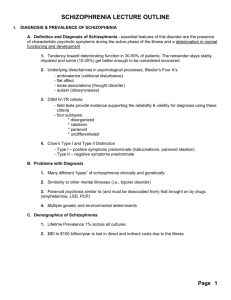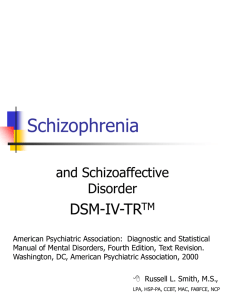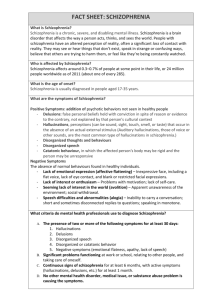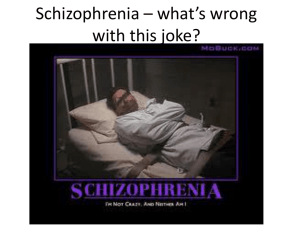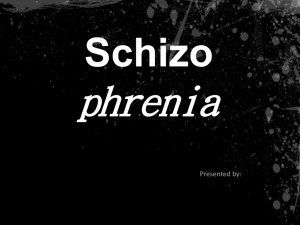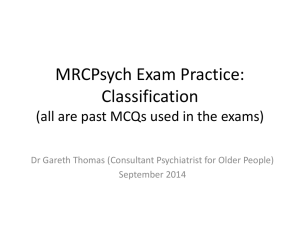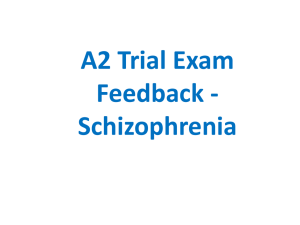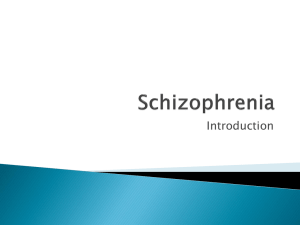DSM-IV
advertisement
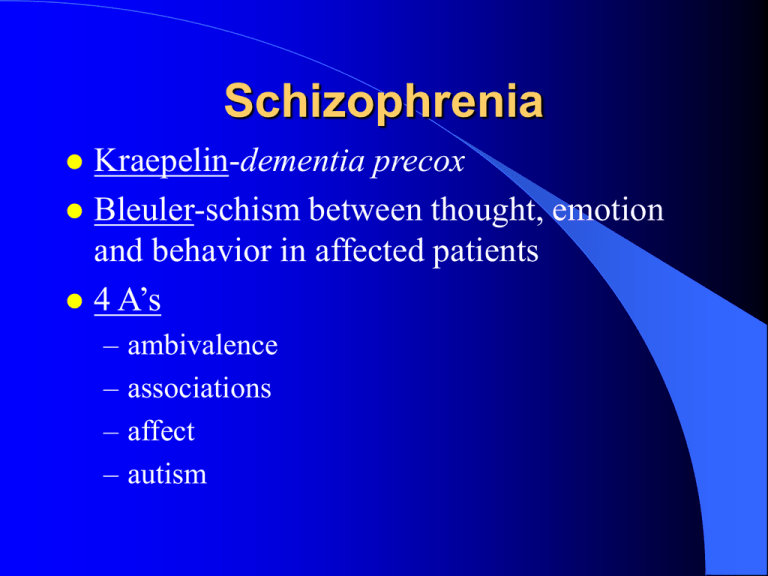
Schizophrenia Kraepelin-dementia precox Bleuler-schism between thought, emotion and behavior in affected patients 4 A’s – – – – ambivalence associations affect autism Schizophrenia and DSM Disturbance of 6 months or more that includes one month of 2 or more* of the following active-phase symptoms – – – – – Delusions Hallucinations (3/4 @ some point) Disorganized Speech Grossly disorganized or catatonic behavior Negative symptoms Positive & Negative Sx. Delusions Hallucinations Disorganized thinking Misperceptions Blunted affect Poor initiation & planning with tasks Poverty of speech Anhedonia Delusions Grandeur Guilt Jealousy Passivity Persecution Poverty Reference Other Symptoms of Schizophrenia Cognitive Dysfunction Dysphoria Absence of Insight Sleep disturbance Suicide Illusions Echopraxia Why accurate Dx is important? Frequency-1% Chronicity – Schizophrenic patients die younger Males 5.1 greater mortality Suicide rate 10-13% higher overall 2x MVAs; More disease & homelessness Severity Management* – 80% vs. 30% relapse rate @ 1 year Epidemiology Gender-15-25 vs. 25-35 Comorbid with substance abuse Deinstitutionalization (>2/3) Dx has increased with the onset of neuroliptics Etiology Many different problems that converge on the same syndrome, not just a single disease >50% of Sx appear to be associated with brain abnormalities (especially + Sx). Stress Diathesis Model Dopamine Hypothesis Genetics G en eral P o p u latio n 1 .0 % N o n tw in sib o f S ch z. p t. 8 .0 % C h ild w ith 1 S ch z. p aren t 1 2 .0 % D y zy g o tic tw in o f S ch z. p aren t C h ild o f 2 S ch z. p aren ts 1 2 .0 % M o n o zy g o tic tw in o f a S ch z. p aren t 4 7 .0 % 4 0 .0 % Factors related to good prognosis in Schizophrenia Late onset Obvious precipitating factors Acute onset Good premorbid social, sexual, and work history Married Family/Personal history of mood disorders Good support systems Positive symptoms Factors related to poor prognosis in Schizophrenia Young and insidious onset No precipitating factors Poor premorbid social, sexual, and work histories Withdrawn, autistic behavior; assaultive history Single, divorced or widowed Neurological signs and symptoms/prenatal trauma Family history of schizophrenia No remission in 3 years; many relapses Medication Issues Chlorpromazine (Thorazine); Fluphenazine (Prolixin); Haloperidol (Haldol); Thiothixene (Navane); Thioridazine (Mellaril) & Perphenazine (Trilafon) Benzodiazepines – Valium (diazepam) – Librium (chordiazepoxide) Tardive dyskenesia Newer drugs (Risperdal, Clozaril & Zyprexa) Tablet or liquid form with “depot formulations” Common antipsychotic medication side effects Dry mouth Constipation Blurred vision Drowsiness Less common antipsychotic medication side effects Decreased sexual desire Menstrual changes Stiff muscles on one side of the neck or jaw Serious antipsychotic medication side effects Restlessness Muscle stiffness Slurred speech Extremity tremors Agranulocytosis Ethnicity and Antipsychotic medication efficacy (Frackiewicz, et al., 1997) Asians responded to lowest dosages Limited AfA results, with differences apparently due to prescribing practices Authors highlight the problem of this line of cross-cultural research where Western ethnic groups are seen as homogenous AfA are diagnosed significantly more with Scz than EA and less with depression Satcher (2001) AfAs and Latinos… AfA more likely to receive medication and less likely to be referred for therapy (Richardson, 2001) Work Behavior Strengths Minimal physical limitations Generally have at least average IQ Medications provide good control over symptoms for most If onset in late 20s, the consumer may have a work history of > HS education Work Behavior Limitations Difficulty multitasking Difficulty interacting with co-workers Difficulty accepting criticism or supervision May have difficulty with customer service or customer contact Cyclic symptoms lead to inconsistent perf. Needs work space with limited stimulation Common types of work accommodations Flexible schedule to allow time off during times when symptoms exacerbate or need “treatment” Loss stress, low stimulation work environment Training and education staff Modifying simple job tasks Developing on site services (e.g. EAP) Comorbidity 91% with accompanying substance abuse or mental health disorders (Judd, 1989) Strongest relationship with mood disorders – – – – 81.4% with comorbid mood disorder 59% with comorbid unipolar depression 22% with comorbid bipolar depression 38% with comorbid mood disorder made at least one suicide attempt – 28.9%% suicide attempts in pts. with comorbid bipolar disorder Cultural variants Women are less vulnerable to cognitive deficits than men (particularly verbal processing) Goldstein, et al., 1998 Sx. Expression on the BSI were significantly higher in HA compared to EA Coelho, et al., 1998 Cognitive differences must be covaried by premorbid language functioning Catatonic Schizophrenia Meets basic criteria for Schizophrenia At least 2 catatonic symptoms predominate: – Stupor or motor immobility (catalepsy or waxy flexibility) – Hyperactivity w/o apparent purpose or not influenced by external stimulation – Mutism or marked negativism – Peculiar posturing, stereotypes, or mannerisms – Echolalia or echopraxia Disorganized Schizophrenia Meets all of the basic criteria for Schizophrenia plus Disorganized behavior Disorganized speech Affect is flat or inappropriate Not meet criteria for Catatonic Schz. Undifferentiated Schizophrenia Meets basic criteria for Schizophrenia but not Paranoid, Disorganized or Catatonic types Diagnosis of exclusion..what is left Residual Type At one time met criteria for Schizophrenia, Catatonic, Disorganized, or Undifferentiated Type No longer has pronounced catatonic behavior, delusions, hallucinations, or disorganized speech or behavior Still ill as indicated by either – Negative symptoms – Attenuated form of at least 2 symptoms of Schz Paranoid Schizophrenia Meets basic criteria for Schizophrenia Preoccupied with delusions or frequent auditory hallucinations None of these symptoms is prominent: – – – – Disorganized speech Disorganized behavior Inappropriate of flat affect Catatonic behavior Schizophreniform Disorder “A” criteria symptoms for at least a month Delusions (only 1 required, if bizarre) Hallucination(s)* Incoherent, derailed, or disorganized speech Severely disorganized or catatonic behavior Negative symptom From prodromal to active and residual, symptoms last at least one month but no longer than six months Factors related to good prognosis of Schizophreniform Disorder Actual psychotic features begin within 4 weeks of the 1st noticeable change in the patient’s functioning or behavior Pt. confused or perplexed when psychotic Good premorbid social or job functioning Affect is neither blunt nor flattened

